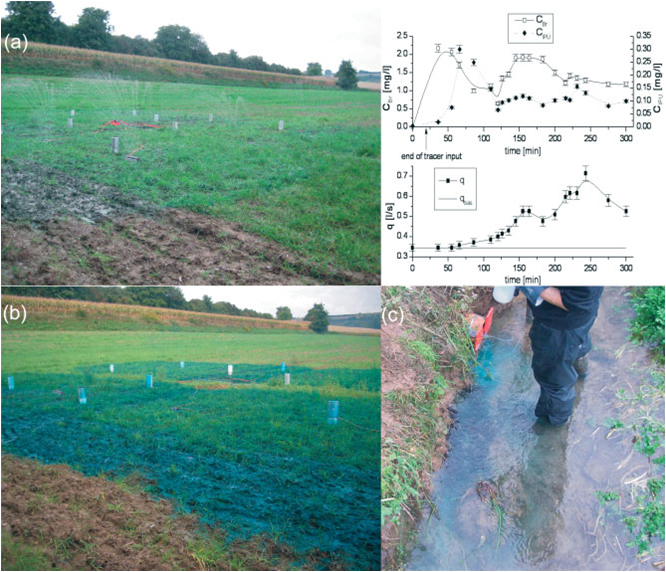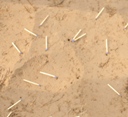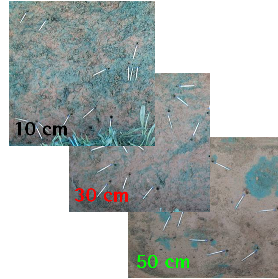Ecohydrological modelling- Linking earthworms and preferential flow
home
aims study sites current work
presentations photo gallery project members cooperation workshop

|
EARTHWORM POPULATIONS |
|
Preferential flow often takes place along
macropores of biological origin, such as earthworm burrows and root
channels. Earthworms are key soil ecosystem engineers that
significantly influence soil organic matter dynamics, hydraulic
properties, pedogenetic processes, and plant performance by modulating
soil structure and forming long-lasting microstructures. They exert
significant influence on process thresholds for preferential flow and
overland flow and the initiation of rapid solute transport. Their
burrows strongly influence infiltration, water movement, aeration,
nitrogen leaching, phosphorous distribution and the fate of pesticides.
Furthermore, the earthworm burrow walls, with their accumulation
of organic carbon content, favourable aerobic conditions and enrichment
in clay content, sustain a high microbial biomass and provide many more
sorption sites than bulk soil. This filter function in the earthworm
burrow walls diminishes strongly with increasing distance from the
burrows, even over the first centimetres. Therefore, earthworms play a
pivotal role in determining the ecosystem filter function and the
provisioning of additional ecosystem services. |
| Catchment Scale Spatial
Distribution |
|
Species distribution models can help us to predict earthworm distributions on different scales. Studies on larger scales are rare due to large efforts in data acquisition, especially if the focus is on process understanding. For catchment scale spatial distribution modelling a Boosted regression tree model approach was used to predict the earthworm distribution in the Weiherbach area. We surveyed management, topography, soil parameters and presence-absence, abundance and fresh weight of anecic earthworms (i.e. Lumbricus terrestris) at 75 locations within the Weiherbach catchment. First results show a presence/absence model of Lumbricus terrestris with acceptable performance (AUC=0.76 after validation). Topographic indices (wetness and Beer’s index) as well as soil parameters such as moisture content, texture and tillage are the most relevant environmental predictors. |
| Small Scale Spatial Distribution |
|
At field
scales earthworm abundance is known to depend on temperature, soil
moisture,
texture and management influence. Within this project the
presence/absence of earthworms is modelled well at catchment scale, but
the abundance modelling results are relatively poor. This is probably
due to the high spatial variability in both earthworms as well as
predictor variables at small scales. Therefore single measurements of
earthworm abundance and predictor variables are not representative of
the average field scale values. Therefore a total number of 225 sampling plots divided over two agricultural fields are used to compare the short range variability of Lumbricus terrestris abundance between a field with high and another with low earthworm abundance. This leads to a recommendation on an earthworm sampling design which may result in a field scale representative value, taking into account short range variability. |
| Population Dynamics |
|
|
|
PREFERENTIAL FLOW PATTERNS |
|
Infiltration variability in the topsoil strongly determines the distribution of precipitation water to surface runoff, soil moisture storage and rapid percolation to groundwater. Slow matrix flow and rapid by-pass, i.e. preferential flow, result in a large variability of flow in the topsoil. As preferential flow may strongly influence the residence time in the top soil filter system, it is generally recognized as one of the most important processes which affect solute transport and contamination – and thus the catchment filter function. Preferential flow rate is found to depend mainly on the infiltration to preferential flow paths as the flow capacity within macropores is not likely to be the limiting factor. Different numbers and sizes of pores may be hydrologically effective under different conditions. The occurrence of preferential flow and its effectiveness at different scales is dependent on the antecedent moisture contents, rainfall forcing and distribution and connectivity of the preferential flow paths. In view of climate change with increasing rainfall intensities, the ability of the macropore system to increase or limit infiltration will determine water distribution to the different filter systems. The residence time in macropores and their filter function depends on their depth distribution and connectivity. |
| Field Scale Flow
Experiment |
|
At a tile-drained field site the mobility of two
different herbicides was studied with a controlled irrigation experiment (approx. 400m2).
The less “sorptive” herbicide is Isoproturon (IPU) (N,N-dimethyl-N′-[4-(1-methylethyl)phenyl]urea)
that is frequently used in this area. IPU has been previously shown to
be
susceptible for fast transport through structured soils (e.g., Zehe and
Flühler, 2001a). Application of IPU at tile-drained sites in  With this study we try to answer the following questions:
|
| Plot Scale Infiltration Patterns |
|
|
|
LINK EARTHWORMS - MACROPORES - FLOW PATTERNS |
|
There are three different earthworm types
which have different burrowing patterns. These result in varying
infiltration
patterns: from rapid deep vertical infiltration to a stronger diffuse
distribution of water and solutes in the upper soil layers. Thus the
spatial distribution of different ecological earthworm types can help
us to
understand the spatial variability in preferential infiltration
patterns. However
varying numbers and sizes of macropores may be hydrologically active
under
different conditions. |
 |
 |
 |
 |
 |
 |
 |
|
| schaik (at) uni-potsdam.de |
|
January 2011 | |||||
